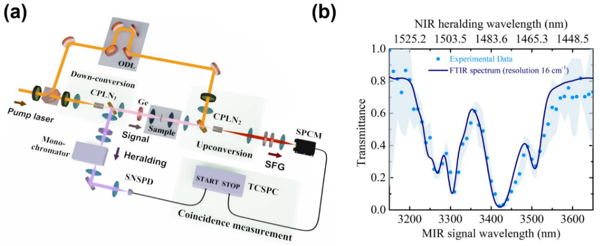The MIR region (2.5-25 μm) is associated with nature-given properties covering vibrations or rotational transitions of complex molecules. As a result, ultra-sensitive MIR spectroscopy has emerged as an important technique for intelligent biochemical sensing, new materials investigation, environmental gas monitoring, and high-precision medical tomography.
With the progress of the nonlinear frequency upconversion in recent years, MIR upconversion spectroscopy has demonstrated great potential. In this approach, a strong pumping field is applied to the nonlinear optical material to convert MIR photons to near-infrared (NIR) or visible wavelengths for detection, overcoming the disadvantages of high-noise MIR detectors and becoming a viable alternative to MIR direct spectral detection. Significant advancements in detection sensitivity, efficiency, response time, and cost-effectiveness are anticipated.
By extending the benefits of ultra-sensitive and broadband MIR frequency upconversion, MIR spectroscopy measurements could be more widely applicable in medical, biological, defense, and other research fields. However, a strong pumping field is usually required to achieve a high conversion efficiency in the broadband frequency upconversion process. Moreover, with a short-wavelength-pumping scheme, strong parasitic noise appears at the wavelength coinciding with MIR signal photons and is subsequently upconverted together with the signal photons to the same wavelength, making ultra-sensitive broadband MIR spectroscopy incredibly challenging.
To address the problems, the research group of E Wu, Yu Chen and Yujie Cai from the State Key Laboratory of Precision Spectroscopy, East China Normal University reported a low-power, robust and ultra-sensitive MIR single-photon frequency upconversion spectroscopy based on temporal-spectral quantum correlation and experimentally verified the spectral measurement of MIR samples at the single-photon level. The relevant research results were published in Photonics Research, Volume 10, No. 11, 2022 (Yujie Cai, Yu Chen, Xiaoning Xin, Kun Huang, E Wu, Mid-infrared single-photon upconversion spectroscopy based on temporal-spectral quantum correlation [J]. Photonics Research, 2022, 10(11): 2614).
This work reported a MIR frequency upconversion spectroscopy scheme at very low photon flux conditions that is based on the temporal-spectral quantum correlation of non-degenerate photon pairs combined with a synchronous frequency upconversion technique. By decreasing the impacts of severe pump parasitic noise and environmental noise on MIR spectral detection, this technique considerably increases the sensitivity and robustness of MIR spectroscopy at the single-photon level.

Fig.1 (a) Schematic of the MIR upconversion quantum spectroscopy experimental setup. (b) Transmission spectra of PS film with the thickness of 38 μm.
The schematic configuration of the MIR single-photon frequency upconversion spectroscopy system is depicted in Fig 1(a). The spontaneous parametric down-conversion process in chirp-poling LiNbO3 generates non-degenerate broadband correlated photon pairs with a photon-pair generation rate of 6.76×106 counts s-1 mW-1. In the experiment, the MIR signal photons cover the region of 3.14-3.80 μm, providing a spectral detection window larger than 660 nm. The scheme relies on synchronous pulse pumping to achieve nonlinear frequency upconversion of the MIR signal photons and verify that the nonclassical correlation between the MIR upconversion photons (0.78-0.81 μm) and the correlated NIR heralding photons is inherited. It demonstrates the feasibility of the MIR upconversion spectroscopy system based on temporal-spectral quantum correlation.
The performance of MIR upconversion quantum spectroscopy based on correlation is validated by the transmission spectral measurement of a piece of polystyrene (PS) film with a thickness of 38 μm, as shown in Fig 1(b). The transmission spectral measurement on the sample is carried out with an incident MIR photon flux of 0.09 average photons per pulse. The spectrum obtained by the MIR upconversion quantum spectroscopy system shows the exactly same profile as the one from the Fourier transform infrared (FTIR) spectrometer. The theoretical spectral resolution of the current system is deduced to be about 11.4 nm (10.5 cm−1).
In comparison to FTIR spectroscopy, broadband MIR single-photon upconversion spectroscopy based on time-spectral quantum correlation can make use of the frequency- and time-correlated quantum properties of photon pairs to lessen the impact of parasitic noises during the frequency upconversion process and increase the sensitivity of MIR spectroscopy to the single-photon level. At the same time, it allows the single-photon detector and monochromator to operate at optimal wavelengths without regard to the characteristic wavelength of the sample to be measured, thereby expanding the system's application scenarios. The system's advantages of high sensitivity, low noise, robustness, and simplicity provide a new technical solution for MIR spectroscopic measurements of photosensitive biochemical samples. More studies on the MIR upconversion spectroscopy imaging will be carried out with broader bandwidth, higher sensitivity, and higher signal-to-noise ratio.







